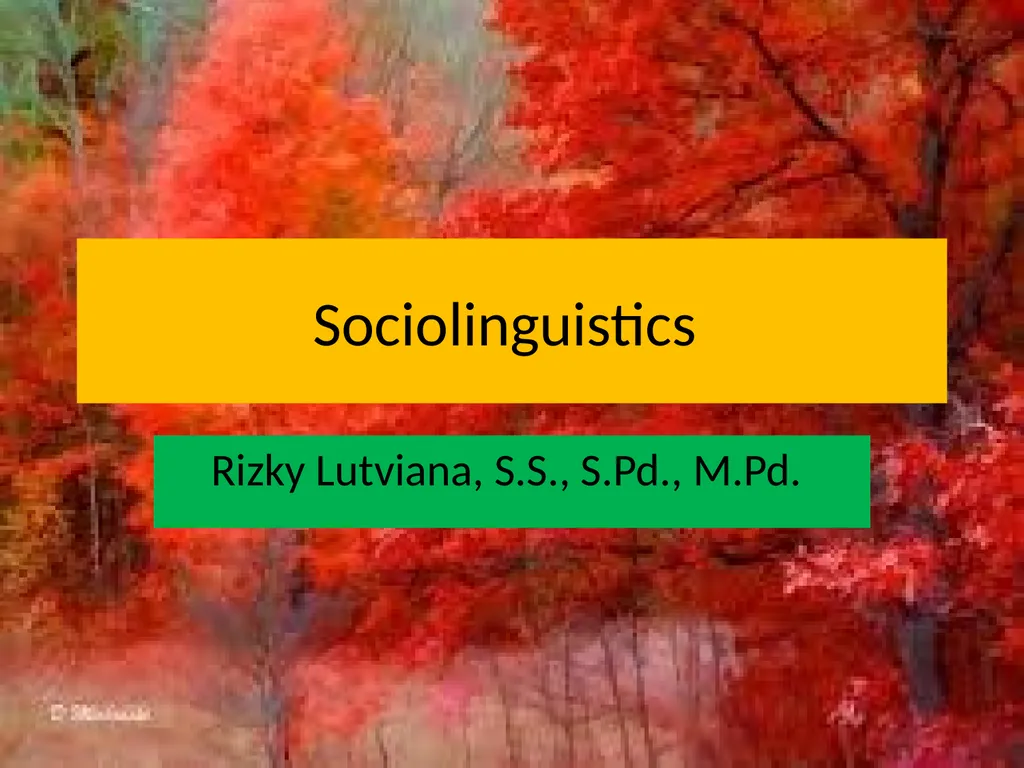Sociolinguistics Rizky Lutviana, S.S., S.Pd.,
Author : celsa-spraggs | Published Date : 2025-11-08
Description: Sociolinguistics Rizky Lutviana SS SPd MPd CHAPTER 1 TERMINOLOGIES FACTORS LANGUAGE CHOICE SOCIAL DIMENSION What is sociolinguistics The study of language variation caused by social factors What do sociolinguistics study
Presentation Embed Code
Download Presentation
Download
Presentation The PPT/PDF document
"Sociolinguistics Rizky Lutviana, S.S., S.Pd.," is the property of its rightful owner.
Permission is granted to download and print the materials on this website for personal, non-commercial use only,
and to display it on your personal computer provided you do not modify the materials and that you retain all
copyright notices contained in the materials. By downloading content from our website, you accept the terms of
this agreement.
Transcript:Sociolinguistics Rizky Lutviana, S.S., S.Pd.,:
Sociolinguistics Rizky Lutviana, S.S., S.Pd., M.Pd. CHAPTER 1 TERMINOLOGIES, FACTORS LANGUAGE CHOICE, & SOCIAL DIMENSION What is sociolinguistics The study of language variation caused by social factors What do sociolinguistics study? Social function of language The relationship between language and context in which it is used Linguistics variation Sociolinguistics ELT Standard pronunciation Speech act Language variety Code switching Gender and age factor Teaching speaking Teaching reading and writing Teaching language components Strategy in teaching Health is a complete state of physical, mental and social well-being, not merely the absence of disease or infirmity Put your rubbish in the bin, Jilly. 3. Give me the right money and tell me where you’re going. Variety: a set of linguistic items with similar distribution, (Hudson, 1996:22) Example: Canadian English, London English, the English of football commentaries, and so on. Variety/code is any set of linguistic forms which patterns according to social factors. In a broader term variety includes different accents, different linguistic styles, different dialects. Factors of language usage Participant Social setting Topic Purpose of interaction Social dimensions Social distance Status Formality functional Social distance scale Intimate Distant High solidarity Low solidarity The status scale Superior Subordinate High status Low status The formality scale Formal Informal High formality Low formality Referential scale Referential High information content Low information content Affective scale Affective Low affective content High affective content CHAPTER 2 LANGUAGE CHIOCE IN MULTILINGUAL COMMUNITIES Variety and Code Case study Bukavu, Zaire Auckland, New Zealand Paraguay Portugal Singapore Bukavu, Zaire Multicultural and multilingual city since more people coming are for work and business rather than living for good. Fourty groups speaking different languages Language varieties Shi: formal shi, informal shi, Swahili: Kingwana, standard Zairean Swahili, Indoubil Auckland, New Zealand Bilingual Tongan Language varieties: Tongan, English Paraguay Language varieties : Spanish, Guarani Spanish, the language of the colonisers, spoken by people who live in cities Guarani, the tribal language of American Indian, spoken by local people Domain of language use, see Holmes p. 22. Portuguese Immigrant people living in another country Language varieties: Portuguese and English Portuguese : home and church English : school and workplace Singapore Factors influence code choice Social Charateristics of participant Purpose Topic Social distance Status Social role Setting Formality Function Assignment Answer these question individually, and then share the answer with your pair. How many languages do you speak? Explain how do you use it by completing this chart













